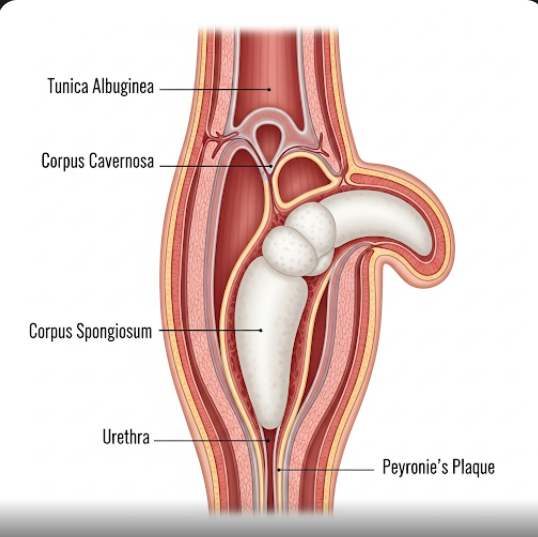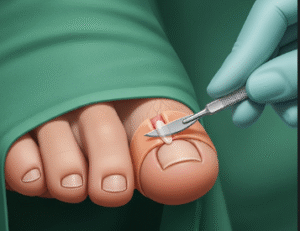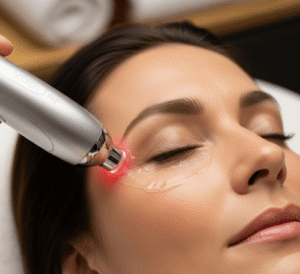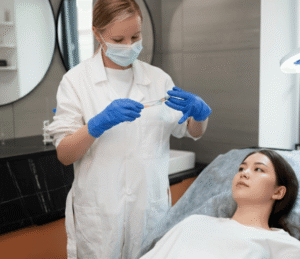Overview
Peyronie’s Disease is a medical condition in which fibrous scar tissue (plaque) develops inside the penis, causing it to bend or curve abnormally during erections. This curvature can be painful, make sexual intercourse difficult or impossible, and lead to emotional distress. While a slight curve in the penis is normal, Peyronie’s Disease involves a more significant and often progressive deformity. Early diagnosis and intervention can improve outcomes and prevent complications.
What is Peyronie’s Disease?
Peyronie’s Disease occurs when scar tissue forms in the tunica albuginea, the elastic membrane surrounding the erectile tissue of the penis. This scar tissue reduces flexibility in part of the penis, causing it to bend or become misshapen during an erection. The condition may develop gradually or appear suddenly and can be either stable (non-progressive) or worsen over time.
There are two phases of Peyronie’s Disease:
- Acute phase: Scar tissue forms, and the penis begins to curve, often with pain.
- Chronic phase: The curve stabilizes, and pain usually decreases, but deformity and erectile dysfunction may persist.
Symptoms
Symptoms of Peyronie’s Disease vary in severity and may include:
- Noticeable curvature of the penis (upward, downward, or to the side)
- Erectile pain, particularly during the acute phase
- Lumps or hard plaques felt under the skin of the penis
- Erectile dysfunction (ED)
- Shortening or narrowing of the penis
- Difficulty with sexual intercourse due to bending or rigidity
- Emotional distress, anxiety, or relationship problems
Not every man with Peyronie’s Disease experiences pain or dysfunction, but even mild symptoms can affect confidence and quality of life.
Causes
The exact cause of Peyronie’s Disease isn’t fully understood, but it is believed to result from:
- Microtrauma or repeated injury to the penis during sexual activity or physical exertion
- Abnormal wound healing that leads to excess scar tissue instead of normal elastic tissue
- Genetic predisposition or familial tendency
- Autoimmune responses in which the body attacks its own tissue
It can also develop without a known cause, especially in older men.
Risk Factors
Several factors increase the risk of developing Peyronie’s Disease:
- Age (most common in men between 40 and 70)
- Family history of Peyronie’s Disease or connective tissue disorders
- Erectile dysfunction
- Vigorous sexual activity or penile trauma
- Dupuytren’s contracture (a hand condition with similar fibrous tissue buildup)
- Diabetes and hypertension
- Smoking and alcohol abuse
Although rare, younger men can also develop the condition, particularly after penile injury.
Complications
Untreated or severe Peyronie’s Disease can lead to complications such as:
- Difficulty or inability to have penetrative intercourse
- Painful erections
- Erectile dysfunction
- Emotional and psychological distress
- Relationship problems or reduced intimacy
- Reduced penis length or deformity
- Depression or anxiety related to body image
Early medical consultation can help prevent these outcomes through medical or surgical management.
Prevention
While not all cases can be prevented, the following measures may help reduce the risk or severity:
- Avoid vigorous sexual activity or positions that put the penis at risk of bending
- Use adequate lubrication during intercourse
- Treat erectile dysfunction early to avoid injury from incomplete erections
- Manage underlying health conditions such as diabetes and high blood pressure
- Quit smoking and limit alcohol consumption
- Seek medical attention promptly after penile trauma
There is no vaccine or medication that prevents Peyronie’s Disease, but lifestyle care and awareness can reduce risk.
Treatment Options in Korea
South Korea offers modern, evidence-based treatment options for Peyronie’s Disease, from conservative therapies to advanced surgical correction:
- Medical Therapy:
- Oral medications (e.g., pentoxifylline) to reduce inflammation
- Collagenase Clostridium histolyticum (Xiaflex) injections directly into the plaque to reduce curvature
- Vitamin E or Potassium para-aminobenzoate (Potaba) as supportive therapy (less commonly used today)
- Non-Surgical Therapies:
- Penile traction devices to help gradually straighten the penis
- Shockwave therapy (in select clinics) to soften plaque and improve blood flow
- Ultrasound therapy for pain relief and plaque softening (limited evidence)
- Surgical Treatments (for severe or persistent cases):
- Plication surgery (shortening the longer side of the penis)
- Grafting procedures (replacing scar tissue with grafts)
- Penile implants for men with severe curvature and erectile dysfunction
- Urology Expertise in Korea:
- Top hospitals such as Seoul National University Hospital, Asan Medical Center, Samsung Medical Center, and Cha Hospital have experienced urologists specializing in men’s health.
- Many offer confidential consultations, minimally invasive procedures, and English-language services for international patients.













